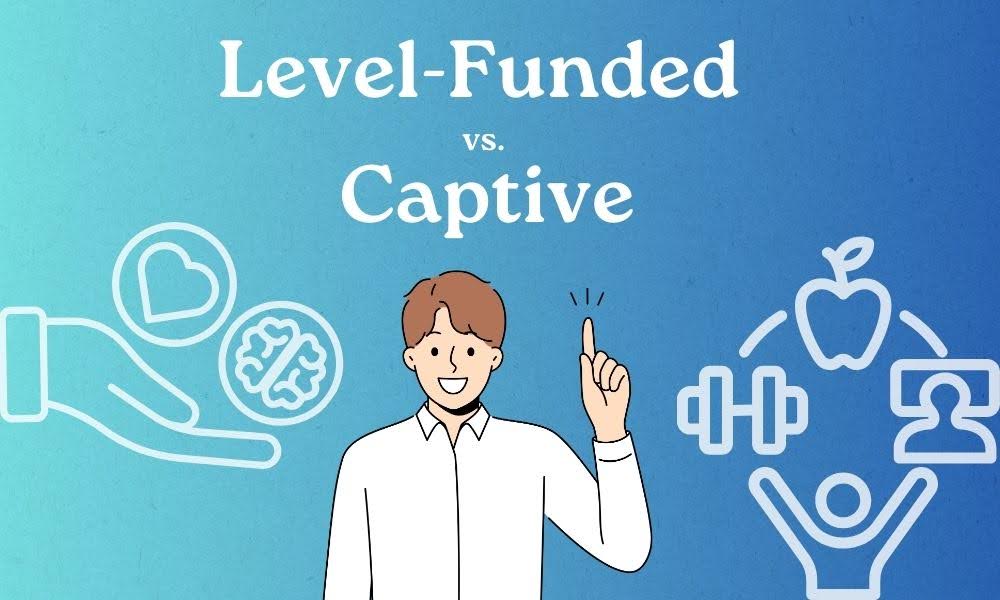For employers navigating the complex world of employee health benefits, finding the right plan can feel overwhelming. Traditional fully insured plans are often the default choice, but alternative models like level-funded insurance and captive health insurance have gained traction in recent years.
Both options promise cost-saving opportunities and greater flexibility, making them appealing for businesses looking to optimize their healthcare spending.
Understanding the key differences between these two models is essential for employers who want to make an informed decision. Whether you’re managing a small business or a larger organization, knowing how these plans work and what they offer can help you tailor your approach to employee health coverage while maintaining control over costs.
What is Level-Funded Insurance?
Level-funded insurance is a cost-saving model that blends elements of traditional fully insured plans with self-funded insurance. Designed to provide predictability and flexibility, this type of health plan involves fixed monthly payments that cover three core components: administrative fees, claims funding, and stop-loss insurance.
Here’s how it works: Employers pay a set amount each month, with part of the payment allocated to a claims reserve fund. This fund is used to cover employees’ medical claims as they arise.
To protect businesses from unexpected high costs, stop-loss insurance kicks in when claims exceed a predetermined limit. This feature ensures that employers are not financially burdened by excessive claims, making level-funded insurance a safer option for businesses compared to traditional self-insurance.
Pros of Level-Funded Insurance
- Cost Predictability: Fixed monthly payments make budgeting easier and reduce financial uncertainty.
- Potential Refunds: Employers may receive a refund if the claims fund has a surplus at the end of the plan year.
- Stop-Loss Protection: Safeguards businesses against high claims, ensuring unexpected costs don’t derail budgets.
- Transparency: Clear separation of administrative fees, claims funding, and stop-loss coverage allows for better understanding and control of expenses.
- Flexibility for Small Businesses: Offers an affordable option for small businesses, particularly those with a healthier workforce.
Cons of Level-Funded Insurance
- Limited Suitability: May not be ideal for businesses with a higher-risk employee population due to increased costs.
- Complexity: Requires careful management and tracking of claims utilization compared to fully insured plans.
- Refund Conditions: Not all employers will qualify for a surplus refund, especially if claims utilization is high.
- Coverage Limitations: These plans are not required to follow state-mandated benefits, which means certain benefits may not be covered.
What is Captive Health Insurance?
Captive health insurance is a self-insurance model where multiple employers come together to form a risk-sharing pool. This pool, often referred to as a “captive,” allows businesses to collectively manage healthcare costs while retaining more control over their insurance plans.
Employers in a captive contribute funds to cover claims and administrative costs, much like level-funded plans, but with the added benefit of shared risks and potential cost savings across the group.
The structure of captive health insurance offers customized coverage, enabling employers to tailor plans based on the unique needs of their workforce. By participating in a captive, businesses can leverage the combined purchasing power of the group to negotiate better rates for services and manage healthcare expenses more effectively. This model is particularly appealing for organizations seeking long-term cost stability and the ability to invest in proactive healthcare initiatives.
Pros of Captive Health Insurance
- Shared Risk: Pooling with other employers reduces the financial impact of high-cost claims.
- Customized Coverage: Plans can be tailored to the specific needs of participating businesses and their employees.
- Potential Savings: Long-term cost savings are achievable through proactive healthcare management and reduced reliance on traditional insurance carriers.
- Greater Control: Employers gain more influence over plan design, provider networks, and wellness initiatives.
- Transparency: Direct access to claims data provides insights into healthcare usage and cost drivers.
Cons of Captive Health Insurance
- Initial Costs: Higher upfront investment is required to join and establish a captive program.
- Complexity: Managing a captive involves more administrative oversight and expertise than traditional plans.
- Group Dependency: The success of the model relies on the health and claims history of all participants in the captive pool.
- Long-Term Commitment: Captive plans often require a multi-year commitment, which may not suit businesses with uncertain growth trajectories.
- Eligibility Restrictions: Smaller businesses may face challenges meeting the entry criteria for some captive programs.
Cost Considerations for Employers
When comparing level-funded insurance and captive health insurance, understanding the cost dynamics of each model is vital. Both offer opportunities for savings compared to traditional fully insured plans, but they differ significantly in terms of upfront expenses, ongoing premiums, and how claims data influences overall cost-effectiveness.
Initial Costs
- Level-Funded Insurance: As mentioned, employers typically pay a fixed monthly premium that includes administrative fees, claims funding, and stop-loss coverage. This structure allows businesses to avoid significant upfront expenses, making it an accessible option for small to mid-sized organizations.
- Captive Health Insurance: Joining a captive often involves a higher initial investment. Employers contribute to a shared pool, and additional setup costs may apply, such as fees for establishing the captive or hiring specialized administrators.
Ongoing Premiums and Adjustments
- Level-Funded Insurance: Premiums remain stable throughout the year, providing cost predictability. At the end of the term, surplus funds from the claims reserve may be refunded, but higher claims could result in increased rates during renewal.
- Captive Health Insurance: Costs fluctuate based on the overall claims performance of the captive group. While this model offers potential long-term savings, participating employers must be prepared for claims-driven adjustments that impact future contributions.
Claims Data and Cost Efficiency
- Level-Funded Insurance: Stop-loss insurance mitigates the financial impact of high-cost claims, offering protection but less direct insight into utilization.
- Captive Health Insurance: Participants in a captive benefit from detailed claims data, enabling them to identify trends, manage healthcare costs more effectively, and implement targeted wellness programs. This transparency enhances funding efficiency and allows employers to take a proactive approach to cost management.
Potential Savings
- Level-Funded Insurance: While savings can be achieved through refunds if claims are low, the more significant savings come from reduced premiums. Level-funded plans typically offer businesses around 25% savings on premiums, making them a cost-effective choice for many employers.
- Captive Health Insurance: By pooling risks and leveraging shared funding structures, captives can deliver long-term cost benefits. However, the success of these savings depends on the overall health and claims performance of the group.
Choosing the Right Plan for Your Business
Deciding between level-funded insurance and captive health insurance depends on factors like company size, claims history, budget, and risk tolerance. Small to mid-sized businesses often favor level-funded plans for their predictable costs and simpler structure. Larger organizations or groups may find captive insurance more appealing for its shared risk and potential long-term savings.
Your claims history and budget are key considerations. Level-funded plans suit businesses with stable claims and a need for cost predictability, while captive insurance requires a higher upfront commitment but offers greater customization and control.
Consulting with a health insurance broker or expert can help you evaluate these options and determine the best fit for your business needs, ensuring a plan that balances employee well-being and financial stability.
Making the Right Choice for Your Business
Choosing between level-funded and captive health insurance isn’t about picking the “best” option—it’s about finding what’s right for your business. By understanding their key differences, weighing the pros and cons, and considering factors like budget, risk tolerance, and claims history, you can make an informed decision that supports both your employees and your bottom line.
Take the time to explore these options with a broker or expert, and you’ll be well on your way to crafting a health plan that works as hard as you do.




